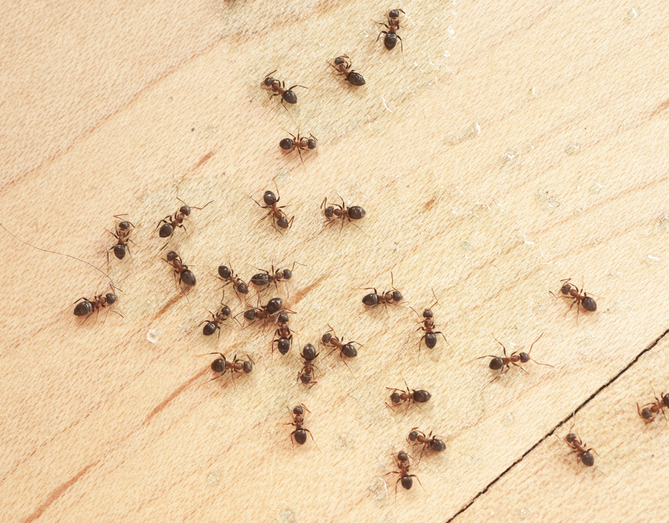Types of Ants: An Informative Guide
Ants are fascinating creatures that have been around for millions of years. They are found almost everywhere on Earth, and their complex social structures and behaviors have been a subject of study for many. In this guide, we will delve into the different types of ants you might encounter and how Orkin can assist you in managing any ant-related issues.
Understanding the Ant World
Ants are not just the tiny creatures you see scurrying around on your kitchen counter. They belong to diverse species, each with its unique characteristics and behaviors. Some of the common ants you might come across include:
Carpenter Ants
- Appearance – Larger ants, ranging from 1/4 to 1/2 inch, black, brown, or reddish
- Habitat – Prefer damp environments, often found in rotting wood and tree stumps
- Behavior – Excavate wood to create nests but don’t consume it
- Diet – Feed on honeydew, insects, and other small invertebrates
- Swarming Season – Spring and early summer
- Sting/Bite – Can bite, slightly painful due to size
- Preferred Nest Locations – Rotting wood, tree stumps, wooden structures in homes
- Foods Preferred Indoors – Sweets, pet food, meat, and other food scraps
Fire Ants
- Appearance – Reddish-brown, about 1/8 to 3/8 inch
- Habitat – Open areas like lawns, parks, and fields
- Behavior – Aggressive when disturbed, build distinctive mounds
- Diet – Omnivorous, feed on seeds, insects, and small animals
- Swarming Season – Spring and fall, especially after rain
- Sting/Bite – Both bite and sting, causing a burning sensation
- Preferred Nest Locations – Soil, creating mounds in open areas
- Foods Preferred Indoors – Sweets, proteins, and greasy foods

Save $50
on your first recurring service today with code GET50

GET A PERSONALIZED QUOTE
To protect your home from pests, click here for a free pest control estimate. Our Orkin Pros will create a personalized pest treatment plan for your home or business
or Call (866) 249-0292
Flying Ants
- Appearance – Winged, typically larger than worker ants
- Habitat – Emerge from established ant colonies
- Behavior – Swarm to mate and establish new colonies
- Diet – As larvae, fed by worker ants. Mature ones focus on reproduction
- Swarming Season – Summer, especially after rain
- Sting/Bite – Depends on species; some can sting or bite
- Preferred Nest Locations – Established ant colonies
- Foods Preferred Indoors – Depends on the specific ant species
Black Ants
- Appearance – Small, black, about 1/8 inch
- Habitat – Gardens, under rocks, inside homes
- Behavior – Often seen in long trails, foraging for food
- Diet – Sweets, meats, and other insects
- Swarming Season – Late spring to early summer
- Sting/Bite – Can bite, not painful
- Preferred Nest Locations – Soil, under rocks or logs, wall crevices
- Foods Preferred Indoors – Sweets, grease, and crumbs
Sugar Ants
- Appearance – Small, light brown to black
- Habitat – Indoors, especially kitchens
- Behavior – Attracted to sweet substances
- Diet – Sugary foods and other organic materials
- Swarming Season – Late spring and early summer
- Sting/Bite – Can bite, not painful
- Preferred Nest Locations – Wall crevices, under floors, behind cabinets
- Foods Preferred Indoors – Sweets, spilled juices, and other sugary foods
Leaf Cutter Ants
- Appearance – Reddish-brown, up to 1/2 inch
- Habitat – Tropical rainforests
- Behavior – Cut leaves and carry them to their nests
- Diet – Fungus cultivated using the cut leaves
- Swarming Season – Early rainy season
- Sting/Bite – Can bite with strong mandibles; some species mildly sting
- Preferred Nest Locations – Underground with intricate tunnel systems
- Foods Preferred Indoors – Not typically found indoors
Argentine Ants
- Appearance – Light brown, about 1/8 inch
- Habitat – Wet environments, often under stones or boards
- Behavior – Invasive, form supercolonies
- Diet – Sweets, eggs, oils, and fats
- Swarming Season – Warm, wet conditions throughout the year
- Sting/Bite – Can deliver a mild bite
- Preferred Nest Locations – Soil, under stones or debris
- Foods Preferred Indoors – Sweets, oils, and fats
Pharaoh Ants
- Appearance – Tiny, yellow to light brown, about 1/16 inch
- Habitat – Warm, humid environments
- Behavior – Can spread diseases, contaminate food
- Diet – Sweets, proteins, and fats
- Swarming Season – Can reproduce throughout the year
- Sting/Bite – Can bite, rarely noticeable
- Preferred Nest Locations – Wall crevices, behind baseboards, under floors
- Foods Preferred Indoors – Sweets, proteins, and other organic materials
Odorous Ants
- Appearance – Small, brown to black, about 1/8 inch
- Habitat – Indoors and outdoors, near moisture sources
- Behavior – Release a foul odor when crushed
- Diet – Sweet foods and other insects
- Swarming Season – Late spring to early summer
- Sting/Bite – Can bite, not painful
- Preferred Nest Locations – Soil, under rocks, near moisture sources
- Foods Preferred Indoors – Sweets and organic materials
Ghost Ants
- Appearance – Tiny, about 1/16 inch, with a dark head and thorax and a translucent, pale abdomen and legs
- Habitat – Warm, humid environments, often found indoors
- Behavior – Known for rapid movements and establishing multiple nests
- Diet – Prefer sweets but will also consume proteins and grease
- Swarming Season – Throughout the year in warmer climates
- Sting/Bite – Do not sting, but can bite, though it’s not painful
- Preferred Nest Locations – Kitchens, bathrooms, and other moist areas
- Foods Preferred Indoors – Sweets and greasy foods
Crazy Ants
- Appearance – About 1/8 inch, reddish-brown to black with long legs and antennae
- Habitat – Typically found under carpets, inside walls, and hidden areas
- Behavior – Erratic and rapid movement, not following typical ant trails
- Diet – Live and dead insects, fruits, seeds, and honeydew
- Swarming Season – Late spring to early summer
- Sting/Bite – Do not sting but can deliver a mild bite
- Preferred Nest Locations – Under debris, carpets, and inside walls
- Foods Preferred Indoors – Almost any household food, especially sweets
Tramp Ants
- Appearance – Small, about 1/16 to 1/8 inch, varying from yellow to brown
- Habitat – Various environments, both indoors and outdoors
- Behavior – Invasive, quickly spreading and displacing native ant species
- Diet – Sweets, grease, and other insects
- Swarming Season – Warmer months, typically late spring and early summer
- Sting/Bite – Do not sting but can bite if threatened
- Preferred Nest Locations – Opportunistic, ranging from soil to inside structures
- Foods Preferred Indoors – Sweets, proteins, and greasy foods
Bigheaded Ants
- Appearance – About 1/8 inch, red, brown, or yellowish with larger heads on soldier ants
- Habitat – Prefer nesting in the soil
- Behavior – Clear division of labor between larger and smaller ants
- Diet – Seeds, insects, and honeydew
- Swarming Season – Warmer months, especially after rain
- Sting/Bite – Can bite, not harmful; do not sting
- Preferred Nest Locations – Soil, creating visible mounds
- Foods Preferred Indoors – Sweets, proteins, and pet food
Acrobat Ants
- Appearance – About 1/8 inch, brown, black, or reddish-brown with a heart-shaped abdomen
- Habitat – Old wood, especially previously infested by termites or other ants
- Behavior – Raise their abdomen over their head when threatened
- Diet – Honeydew, insects, and sweets
- Swarming Season – Late spring to early summer
- Sting/Bite – Can both sting and bite; sting causes a slight burning sensation
- Preferred Nest Locations – Old wood, tree stumps, and logs
- Foods Preferred Indoors – Sweets and other organic materials
Thief Ants
- Appearance – Tiny, about 1/16 inch, yellow to light brown
- Habitat – Often nest close to other ant colonies
- Behavior – Steal food and larvae from neighboring ant colonies
- Diet – Proteins, meats, grease, seeds, and dead rodents
- Swarming Season – Late summer
- Sting/Bite – Can sting, usually not painful; can also bite, generally harmless
- Preferred Nest Locations – Soil, close to other ant colonies
- Foods Preferred Indoors – Meats, dairy products, and greasy foods
Why do Ants Enter Homes?
Ants enter homes for various reasons, such as searching for food, water, or even to start a new colony. Some species produce winged ants that swarm from their nests, mate, and then form new colonies. These winged ants, when found indoors, indicate that their colony might be inside the house.
Orkin’s Expertise in Ant Control
At Orkin, we understand the biology and behavior of different ant species. Our approach is not just about eliminating the ants you see but targeting the entire colony. Spraying insecticides on ant trails might kill a few ants but won’t address the root of the problem. In fact, such treatments can sometimes cause a colony to split, making the issue worse.
Orkin’s Solution: Our trained professionals will first identify the ant species causing the problem. Based on the species and its behavior, we will devise a strategy to eliminate the entire colony, ensuring long-term relief.
Frequently Asked Questions
Why do I see winged ants in my home?
Winged ants are usually a sign of a mature colony looking to form a new one. If you see them indoors, it might indicate a colony inside your home.
Are all ants harmful?
No, not all ants are harmful. While some like carpenter ants can damage structures, others are merely a nuisance.
How does Orkin treat ant infestations?
Orkin focuses on eliminating the entire ant colony, not just the visible ants. Our treatment varies based on the ant species and its behavior.
Can I prevent ants from entering my home?
Yes, ensuring that your home is free from food crumbs, sealing entry points, and regular inspections can help prevent ant infestations.
Do all ants bite?
No, not all ants bite. However, some like fire ants can sting and cause discomfort.
How long does it take to get rid of ants?
The time varies based on the ant species and the size of the infestation. Orkin ensures a thorough job to provide long-term relief.
Are DIY ant treatments effective?
While some DIY treatments can offer temporary relief, they might not address the root of the problem, which is the entire colony.
Why choose Orkin for ant control?
With years of experience and expertise, Orkin provides effective and long-lasting solutions for all your ant problems.
Call Orkin for Expert Ant Control
If you’re facing an ant infestation, don’t wait. Call Orkin today and let our experts provide you with a comprehensive solution. Remember, when it comes to pests, trust only the best. Trust Orkin.

FIND YOUR LOCAL BRANCH
To protect your home from pests, click here for a free pest control estimate. Our Orkin Pros will create a personalized pest treatment plan for your home or business
or Call (866) 249-0292

